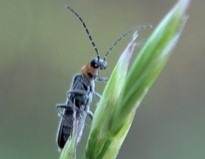Soldier Beetles: Difference between revisions
No edit summary |
No edit summary |
||
| Line 1: | Line 1: | ||
== Description & Overview == | == Description & Overview == | ||
{| class="wikitable" style="text-align:center; float:right; margin-left: 10px; | |||
|+ !colspan="2" style="min-width:12em; text-align: center; background-color: rgb(235,235,210)|'''Soldier Beetle Taxonomy <ref name= "bugguide">BugGuide. (2025). Family Cantharidae - Soldier Beetles. BugGuide. https://bugguide.net/node/view/118/tree.</ref>''' | |||
|- | |||
| [[File:soldierbeetle.jpeg|501px|thumb|Soldier Beetle on a Plant in South Carolina, USA (Photographed by bec325, 2025). <ref name= "pics">iNaturalist. https://www.inaturalist.org/.</ref>]] | |||
|- | |||
!style="min-width:6em; |Kingdom: | |||
|style="min-width:6em; |[[Animals|Animalia]] | |||
|- | |||
!style="min-width:6em; |Phylum: | |||
|style="min-width:6em; |Arthropoda | |||
|- | |||
!style="min-width:6em; |Subphylum: | |||
|style="min-width:6em; |Hexapoda | |||
|- | |||
!style="min-width:6em; |Class: | |||
|style="min-width:6em; |Insecta | |||
|- | |||
!style="min-width:6em; |Order: | |||
|style="min-width:6em; |Coleoptara | |||
|- | |||
!style="min-width:6em; |Suborder: | |||
|style="min-width:6em; |Polyphaga | |||
|- | |||
!style="min-width:6em; |Family: | |||
|style="min-width:6em; |Cantharidae | |||
|- | |||
!style="min-width:6em; |Subfamily: | |||
|style="min-width:6em; |Myrmicinae | |||
|- | |||
|colspan="2" |Image Source: iNaturalist <ref name= "pics">iNaturalist. https://www.inaturalist.org/.</ref> | |||
|} | |||
Soldier beetles (Cantharidae) are the second largest group in the beetle (Coleoptera) superfamily Elateroidea, containing approximatley 5,500 species <ref name= "motyka">Motyka, M., Kusy, D., Biffi, G., Geiser, M., Kazantsev, S.V., Bilkova, R., Jahodarova, E., Vogler, A.P., Bocak, L.. (2023). Untangling the evolution of soldier beetles ([[Coleoptera]]: Cantharidae) and the evaluation of the morphological phylogenetic signal in a soft-bodied elateroid lineage. Cladistics. 39: 548-570. https://doi.org/10.1111/cla.12555.</ref>. Soldier beetle larvae tend to be darkly colored and look almost reptilian. Adult soldier beetles grow to about half of an inch long and are yellow to tan in color. Some abdominal segments are exposed, as their wings do not entirely cover their body. These [[insects]] are beneficial, as they mainly feed on nectar and act as a pollinator species <ref name= "hahn">Hahn, Jeffrey. (2023). Soldier beetles. University of Minnesota Extension. https://extension.umn.edu/yard-and-garden-insects/soldier-beetles#:~:text=Soldier%20beetles%20are%20beneficial%20insects&text=Because%20of%20their%20frequent%20contact,go%20away%20on%20their%20own.</ref>. | Soldier beetles (Cantharidae) are the second largest group in the beetle (Coleoptera) superfamily Elateroidea, containing approximatley 5,500 species <ref name= "motyka">Motyka, M., Kusy, D., Biffi, G., Geiser, M., Kazantsev, S.V., Bilkova, R., Jahodarova, E., Vogler, A.P., Bocak, L.. (2023). Untangling the evolution of soldier beetles ([[Coleoptera]]: Cantharidae) and the evaluation of the morphological phylogenetic signal in a soft-bodied elateroid lineage. Cladistics. 39: 548-570. https://doi.org/10.1111/cla.12555.</ref>. Soldier beetle larvae tend to be darkly colored and look almost reptilian. Adult soldier beetles grow to about half of an inch long and are yellow to tan in color. Some abdominal segments are exposed, as their wings do not entirely cover their body. These [[insects]] are beneficial, as they mainly feed on nectar and act as a pollinator species <ref name= "hahn">Hahn, Jeffrey. (2023). Soldier beetles. University of Minnesota Extension. https://extension.umn.edu/yard-and-garden-insects/soldier-beetles#:~:text=Soldier%20beetles%20are%20beneficial%20insects&text=Because%20of%20their%20frequent%20contact,go%20away%20on%20their%20own.</ref>. | ||
== Taxonomy == | == Taxonomy == | ||
| Line 15: | Line 46: | ||
<ref name= "motyka">Motyka, M., Kusy, D., Biffi, G., Geiser, M., Kazantsev, S.V., Bilkova, R., Jahodarova, E., Vogler, A.P., Bocak, L.. (2023). Untangling the evolution of soldier beetles ([[Coleoptera]]: Cantharidae) and the evaluation of the morphological phylogenetic signal in a soft-bodied elateroid lineage. Cladistics. 39: 548-570. https://doi.org/10.1111/cla.12555.</ref> | <ref name= "motyka">Motyka, M., Kusy, D., Biffi, G., Geiser, M., Kazantsev, S.V., Bilkova, R., Jahodarova, E., Vogler, A.P., Bocak, L.. (2023). Untangling the evolution of soldier beetles ([[Coleoptera]]: Cantharidae) and the evaluation of the morphological phylogenetic signal in a soft-bodied elateroid lineage. Cladistics. 39: 548-570. https://doi.org/10.1111/cla.12555.</ref> | ||
<ref name= "hahn">Hahn, Jeffrey. (2023). Soldier beetles. University of Minnesota Extension. https://extension.umn.edu/yard-and-garden-insects/soldier-beetles#:~:text=Soldier%20beetles%20are%20beneficial%20insects&text=Because%20of%20their%20frequent%20contact,go%20away%20on%20their%20own.</ref> | <ref name= "hahn">Hahn, Jeffrey. (2023). Soldier beetles. University of Minnesota Extension. https://extension.umn.edu/yard-and-garden-insects/soldier-beetles#:~:text=Soldier%20beetles%20are%20beneficial%20insects&text=Because%20of%20their%20frequent%20contact,go%20away%20on%20their%20own.</ref> | ||
<ref name= "colorado">Colorado State University. (2017). Soldier Beetle. Western Colorado Insects. https://wci.extension.colostate.edu/wp-content/uploads/sites/14/2017/03/SoldierBeetles.pdf.</ref> | |||
<ref name= "bugguide">BugGuide. (2025). Family Cantharidae - Soldier Beetles. BugGuide. https://bugguide.net/node/view/118/tree.</ref> | |||
<ref name= "pics">iNaturalist. https://www.inaturalist.org/.</ref> | <ref name= "pics">iNaturalist. https://www.inaturalist.org/.</ref> | ||
Revision as of 17:18, 11 April 2025
Description & Overview
 | |
| Kingdom: | Animalia |
|---|---|
| Phylum: | Arthropoda |
| Subphylum: | Hexapoda |
| Class: | Insecta |
| Order: | Coleoptara |
| Suborder: | Polyphaga |
| Family: | Cantharidae |
| Subfamily: | Myrmicinae |
| Image Source: iNaturalist [2] | |
Soldier beetles (Cantharidae) are the second largest group in the beetle (Coleoptera) superfamily Elateroidea, containing approximatley 5,500 species [3]. Soldier beetle larvae tend to be darkly colored and look almost reptilian. Adult soldier beetles grow to about half of an inch long and are yellow to tan in color. Some abdominal segments are exposed, as their wings do not entirely cover their body. These insects are beneficial, as they mainly feed on nectar and act as a pollinator species [4].
Taxonomy
Ecology & Evolution
From midsummer to early fall soldier beetles tend to pollinate yellow flowers of the family Asteraceae. Adults soldier beetles feed exclusively on pollen [5].
Soldier beetle eggs are laid from late August to early September. Though soldier beetle life history is not well known, larvae are assumed to predate on small invertebrates within the soil. Some soldier beetles are able to produce compounds that help stave off predators, like spiders [5].
References
- ↑ 1.0 1.1 BugGuide. (2025). Family Cantharidae - Soldier Beetles. BugGuide. https://bugguide.net/node/view/118/tree.
- ↑ 2.0 2.1 2.2 iNaturalist. https://www.inaturalist.org/.
- ↑ 3.0 3.1 Motyka, M., Kusy, D., Biffi, G., Geiser, M., Kazantsev, S.V., Bilkova, R., Jahodarova, E., Vogler, A.P., Bocak, L.. (2023). Untangling the evolution of soldier beetles (Coleoptera: Cantharidae) and the evaluation of the morphological phylogenetic signal in a soft-bodied elateroid lineage. Cladistics. 39: 548-570. https://doi.org/10.1111/cla.12555.
- ↑ 4.0 4.1 Hahn, Jeffrey. (2023). Soldier beetles. University of Minnesota Extension. https://extension.umn.edu/yard-and-garden-insects/soldier-beetles#:~:text=Soldier%20beetles%20are%20beneficial%20insects&text=Because%20of%20their%20frequent%20contact,go%20away%20on%20their%20own.
- ↑ 5.0 5.1 5.2 Colorado State University. (2017). Soldier Beetle. Western Colorado Insects. https://wci.extension.colostate.edu/wp-content/uploads/sites/14/2017/03/SoldierBeetles.pdf.